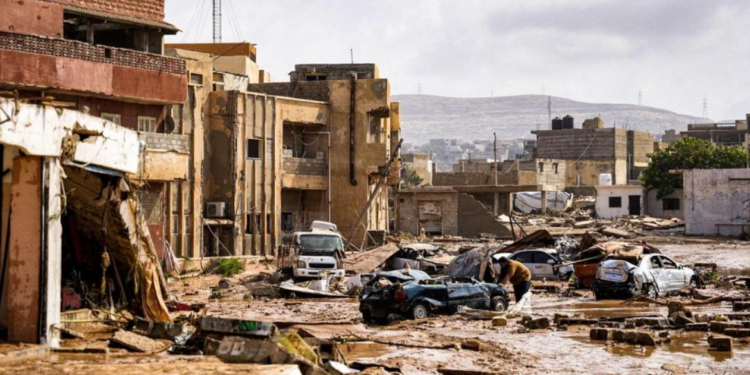
The reported death toll in eastern Libya now exceeds 5,000 people, according to officials.
A hospital director within the city informed a Reuters reporter on Monday that his hospital has documented 1,700 bodies, while another 500 have been buried elsewhere in the city.
In Derna, Libya, a frantic search for thousands of missing people persists, marking its third day since the catastrophic flooding.
The confirmed death toll has already reached thousands, and there is grim anticipation of further fatalities.
The devastating flood, which engulfed a substantial portion of the Mediterranean city, was precipitated by a powerful storm. This tempest ruptured dams nearby, leading to a relentless rush of water that obliterated buildings and claimed the lives of their residents.
One Derna resident, Mustafa Salem, told Reuters reporters he had so far lost 30 members of his family.
Moreover, aid convoys and trucks carrying bulldozers were seen heading towards the city on Wednesday.
A comparison of satellite photos taken before and after the disaster reveals a striking transformation.
The previously narrow waterway in the city centre has expanded considerably in width, and all the structures that used to line its banks have vanished.
In addition, other parts of the city bear the unmistakable signs of extensive damage, with buildings conspicuously absent, a result of floodwaters escaping from the waterway.
According to the United Nations, the deadly floods in the Library are described as a “calamity of epic proportions”, noting the latest figures suggesting more than 5,000 people dead and about 10,000 have been reported missing.
The UN Secretary-General António Guterres has sent his condolences to the Libyan authorities and the families of those who have died.
He said the UN was working with the authorities to assess needs and support relief efforts.
On their part, the World Health Organization (WHO) has estimated that no fewer than 1.8 million people have been affected by the torrential floods that hit several cities in the country.
Similarly calling the disaster “epic”, WHO spokesperson Margaret Harris said, “There’s not been a storm like this in the region in living memory, so it’s a great shock”.
Furthermore, President Joe Biden said in a statement Tuesday that the United States is sending emergency funds to relief organizations and coordinating with the Libyan authorities and the U.N. to provide additional support.
The storm hit other areas in eastern Libya, including the town of Bayda, where about 50 people were reported dead.
The Medical Center of Bayda, the main hospital, was flooded and patients had to be evacuated, according to footage shared by the centre on Facebook.
Other towns that suffered included Susa, Marj and Shahatt, according to the government. Hundreds of families were displaced and took shelter in schools and other government buildings in Benghazi and elsewhere in eastern Libya.
Northeast Libya is one of the country’s most fertile and green regions. The Jabal al-Akhdar area — where Bayda, Marj and Shahatt are located — has one of the country’s highest average annual rainfalls, according to the World Bank.
The Nigerian National Petroleum Company has said that President Bola Ahmed Tinubu has the final…
FirstBank, the oldest bank in Nigeria and part of FBN Holdings’ entities has exited close…
The 125,000 barrels per day Warri Refining and Petrochemicals Company, WRPC has commenced operations. …
Jimmy Carter, a former president of the United States of America, USA, has died at…
The Federal Government has alleged that the Central Bank of Nigeria (CBN) misappropriated N2.73tn in…
President Bola Tinubu will announce his ambassadors within the next few weeks, one of his…